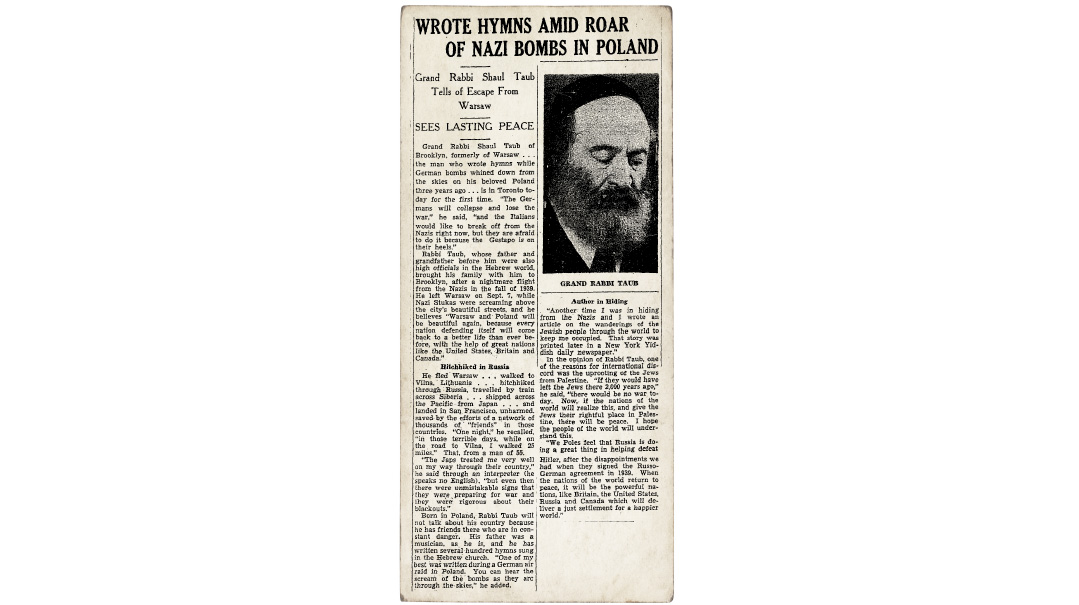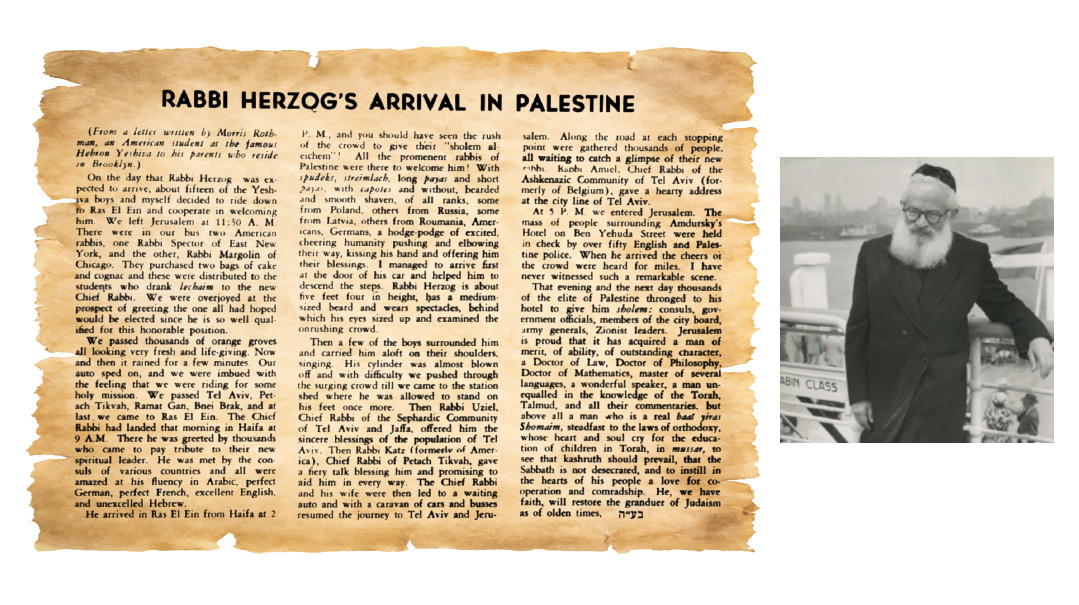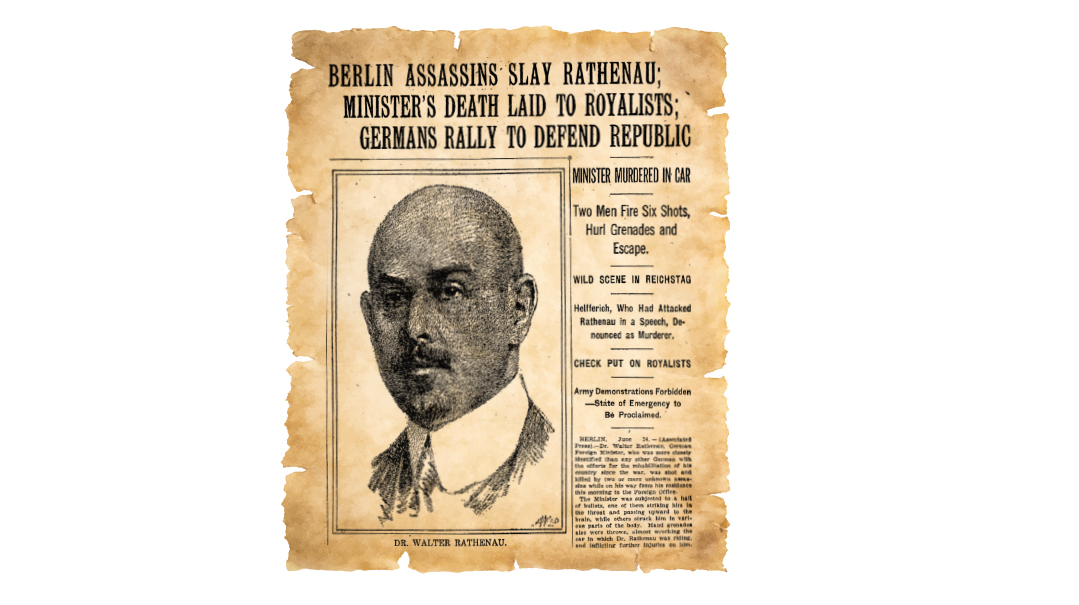An Anthem for the Ages
| September 28, 2022His new “Proik Yas Anach” soon emerged as the theme song of an eternal people facing challenging circumstances

Title: An Anthem for the Ages
Location: Toronto, Canada
Document: Toronto Daily Star
Time: December 1942
The origins of the Modzhitz chassidic dynasty lie in the town of Kazimierz Dolny, which the Jews referred to as Kuzmir. Chassidim would travel by boat down the Vistula River from Warsaw to bask in the presence of Rav Yechezkel Taub of Kuzmir, a follower of the Chozeh of Lublin and the Kozhnitzer Maggid. The spiritual power of niggun was central to his avodah, and his descendants would have an outsized impact on chassidus of central Poland.
His grandson Rav Yisrael Taub — the Divrei Yisrael — settled further upstream in a suburb of the town of Deblin known as Modzhitz. Toward the end of his life, he moved to Warsaw, and his son and successor Rav Shaul Yedidya Taub — the Imrei Shaul — moved to the Warsaw suburb of Otwock in 1929. Chassidim from all over Poland would flock to this resort town to spend Shabbos in the elevated atmosphere of Modzhitzer niggunim.
The summer of 1939 brought rumblings of war from Nazi Germany to the west, and Polish Jewry feared an invasion. When the blitzkrieg arrived on September 1, 1939, the first few weeks were filled with doubt and gloom. Chassidim sought the Rebbe’s counsel, and he acknowledged that he was uncertain himself. He ultimately decided to flee, but those dark weeks in Warsaw produced a new niggun that gave poetic expression during those dark times. Taken from the words in “Kah Ribon” customarily sung on Friday night, “Proik Yas Anach” expressed the deepest yearnings of Jews in Poland at the time, begging Hashem to redeem them from the mouth of the lion, to save His chosen people from the coming destruction.
Seeking an escape route out of the inferno, the Imrei Shaul traveled to Vilna, where locals and refugees, among them thousands of yeshivah students, were exposed for the first time to the warmth of Polish chassidus. Drawn by his magnetic personality, many participated in his Friday night tish, where he taught them his new “Proik Yas Anach,” which soon emerged as the theme song of an eternal people facing challenging circumstances.
After a harrowing journey through Russia and Japan, the Modzhitzer Rebbe managed to reach North America. Upon arrival, he publicly praised the Soviet government several times, including in his speech in Toronto. American Orthodox Jews were a bit surprised at hearing a prominent chassidic rebbe commend the Communists, who had attempted to uproot traditional Jewish life.
But the Rebbe was a wise man. As one of the first to escape over the route through the Soviet Union to Japan and then San Francisco, he was trying to light the path for other desperate Jews fleeing the Nazi onslaught. He calculated that if a prominent personality such as he went out of his way to praise the Bolshevik regime, then the Soviets would grant exit visas to other refugees as well.
The Rebbe settled in America on South 5th Street in Williamsburg, but didn’t stay very long. In June 1947, he decided to transfer his court to the Holy Land. Shortly after arriving in Eretz Yisrael, he took ill, and on the 16th of Kislev (November 29), the very day that the UN General Assembly adopted the historic Partition Resolution for Palestine, he was niftar.
In spite of the danger of ambush, the funeral, accompanied by leading gedolim, including the Chazon Ish and Rav Arele Belzer, proceeded to Har Hazeisim, where the Imrei Shaul’s was among the final burials to take place prior to the 1948 Jordanian takeover. It wasn’t until the 1967 unification of Jerusalem that a matzeivah was placed on the Rebbe’s kever.
A Niggun on Dizengoff
Rav Shaul Yedidya was succeeded by his son Rav Shmuel Eliyahu Taub, who had stayed in Eretz Yisrael permanently after accompanying his father on a 1935 visit there. He established the Modzhitz court on Rechov Dizengoff in Tel Aviv, and it was one of the last chassidic courts to leave the city when his son Rav Yisrael Dan finally moved to Bnei Brak in 1995.
Holocaust Anthem
Reb Azriel David Fastag was a Modzhitzer chassid in prewar Warsaw and an acclaimed chazzan and composer. He was a member of a very prominent Modzhitz family, and his singing drew crowds to his Shalosh Seudos from all over Warsaw. His most famous composition was a haunting rendition of “Ani Ma’amin,” which he likely sang in 1942 on his last train ride from the Warsaw Ghetto to the gas chambers in Treblinka. Layers of legend have accumulated over the decades, but that niggun was undoubtedly beloved by the Modzhitzer Rebbe, popularized by legendary Modzhitz composer Benzion Shenker, and sung by Jews worldwide in memory of the kedoshim of the Holocaust.
For more on the Modzhitzer Rebbe, check out the Jewish History Soundbites episode entitled “Chassidic Symphony: The Modzitz Dynasty,” and the highly recommended book The Modzitzer Rebbe: His Daring Escape from Poland to America and Aliyah by Dr. Chaskel Wyszkowski.
(Originally featured in Mishpacha, Issue 930)
Oops! We could not locate your form.






